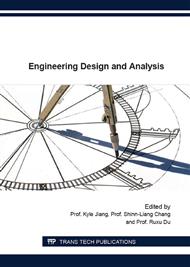p.8
p.15
p.23
p.28
p.35
p.40
p.45
p.50
p.55
Research of Local Constraint for Simplified Half-Rotating Mechanism
Abstract:
In order to meet the requirements of the bionic flying, traditional Half-Rotating Mechanism (HRM) should be simplified because its structure was too complex and heavy. The design idea of simplified HRM was firstly introduced in this paper. Simplified HRM could be achieved by adding a local constraint made of positioning slider and shaft with groove in the slider-crank mechanism. To make sure the movement of simplified HRM was smooth and reliable, relative motion characteristics of positioning slider in groove of shaft had been analyzed and the curve of shaft with groove had been designed. The key parameters, such as radius and center position of inner and outer arc, had been calculated. A case study based on Unigraphics software was finally given and different states of positioning slider in one running cycle had been shown. The study results indicated that the method of simplifying HRM was effective and design of local constraint was accurate. The above research would provide some helpful advices for HRM application.
Info:
Periodical:
Pages:
35-39
Citation:
Online since:
February 2016
Authors:
Price:
Сopyright:
© 2016 Trans Tech Publications Ltd. All Rights Reserved
Share:
Citation:


